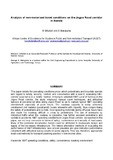| dc.description.abstract | This paper details the prevailing conditions under which pedestrians and bicyclists operate
with regard to safety, security, comfort, and convenience with a view to evaluating NMT
corridor experience in a holistic manner. In trying to establish NMT Level of Service on the
Jogoo Road corridor, the study employed manual count techniques, and attitudinal
surveys at pre-selected sites along Jogoo Road so as to capture typical NMT operating
environment especially at peak hours. The roadway capacity is today extremely
constrained and matatus (paratransit) invade sidewalks with impunity, thus compromising
the safety of pedestrians and cyclists. Over-speeding motorists during off peak hours have
also made the roadway difficult to cross by pedestrians. The use of sidewalks by
motorized traffic when the roadway is congested has further exposed pedestrians and
cyclists to accidents. NMT operating conditions on Jogoo Road corridor, as reported in this
paper, are not very conducive in terms of safety, convenience and security of road users.
Many of the problems documented herein could be attributed to inadequate design and
supply of the necessary infrastructure. The tested alternative methods of evaluating the
performance of NMT infrastructure have proven plausible and give indicative performance
consistent with attitudinal survey results on some aspects. They are, therefore, appropriate
least-cost methods for transport planning practice in low-income cities. | en |

